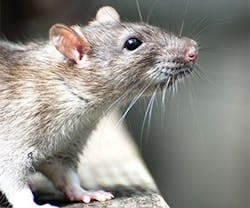While Mouse Trap may be a fun game for kids, there’s nothing playful about dealing with a rodent invasion as a facility manager. Beyond the gross factor, rodents can cause serious structural damage to your building’s most sensitive systems.
If you have concerns about using traditional traps or poisons, approach the situation using integrated pest management. Patrick Copps, an entomologist and Technical Services Manager for Orkin, and Chad Gore, an entomologist and Regional Tech-nical Director for Rentokil, share prevention tips to discourage rats and mice.
No Small Problem
Gore: Rodents have the potential to transmit diseases. They often carry parasites such as ticks and fleas that can infect humans. Their droppings and saliva can also be contaminated with harmful bacteria and viruses. Not only can an infestation hurt your company’s brand, but it can undercut employee morale.
Copps: In addition to being a health issue, feces can stain building materials. Rodents also gnaw on and burrow into their surroundings. They can chew through wood, food containers, plastic plumbing and electrical conduit. And once they get inside your walls, insulation is an ideal spot for their nests.
Avoid Inviting Rodents
Gore: All organisms require food, shelter and water. Take any one of those away and you begin to stress the animal out. The worst thing you can do is inadvertently support those basic needs through poor maintenance.
For example, any clutter around your facility offers rodents a place to shelter and nest. Also look to your sanitation practices. Mice and rats can easily locate crumbs from employees eating at their desks or get into poorly stored food. While mice can metabolize water from their food, rats have a daily requirement for hydration – eliminate any possible sources of standing and leaking water.
You also shouldn’t have a lot of vegetation up against the building because plants can offer a natural habitat. You don’t have to rip out all landscaping – just have enough of a clearance to inspect your foundation. For example, use peat gravel to create a sanitation border along exterior walls.
Copps: Look at the access to your structure. Mice can squeeze through a quarter-inch gap and rats only need a half inch. Plus they can use their teeth to make any opening bigger. If a hole is the width of a pencil, there’s a good chance it’s letting in rodents. Pay special attention to gaps under doors, tears in window screens, envelope cracks, and penetrations around utility connections, piping and skylights.
Trash and litter will also attract rodents. Make sure any dumpsters, cans or compactors are positioned away from the building, have tight seals and are cleaned periodically.
If you have a dock, deliveries may be a source of an infestation. Mice and rats can arrive on pallets, food materials or cardboard cartons. Routinely check for droppings when receiving shipments and follow up with the supplier if necessary. Pest management is a chain – everyone needs to take care of their own property so they’re not causing others grief.
Greener Pest Methods
Gore: There’s not a one-size-fits-all approach. A good rodent management program includes several control layers that are tailored to your facility.
Start with routine inspections. These can be done on a monthly basis with extra attention during the fall when rodents need to protect themselves against the cold. Droppings are the most obvious indicator, though urine can be harder to spot. Damage from chewing and shredded materials are another clue. Also look for rub marks near openings and crevices – these dirty streaks are caused by the oils in their fur. Be mindful that some rodents can climb, so don’t forget to check your roof.
For persistent infestations, there are motion-activated and IR cameras like the ones used for animal trails. These will help you target frequently traveled areas.
Copps: Sticky boards can be used as a last resort in heavy infestations. Deploy them as an overnight blitz and make sure to empty traps quickly. Otherwise you’re letting the animal starve to death.
Keep in mind that catch-and-release isn’t appropriate for this type of pest; it only puts people at risk because rodents will return with the help of pheromone markings. If your best preventive measures have failed, judicious use of rodenticides have their place under integrated pest management.
Jennie Morton [email protected] is Senior Editor of BUILDINGS.
About the Author
Jennie Morton
A former BUILDINGS editor, Jennie Morton is a freelance writer specializing in commercial architecture, IoT and proptech.
